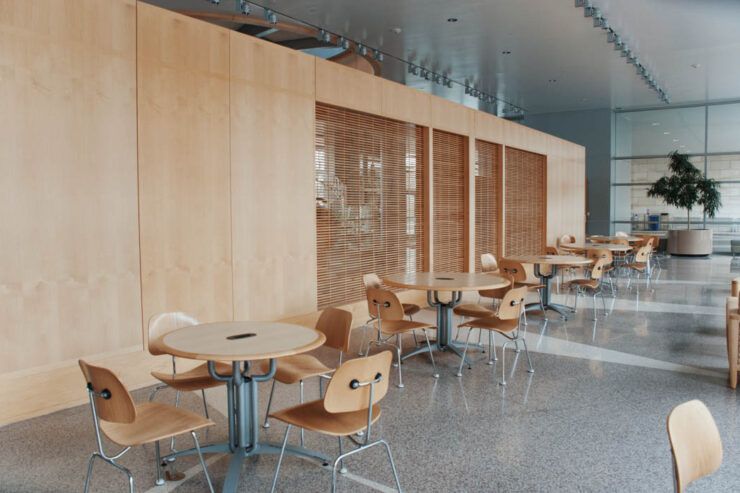4 lessons on making remote work make sense for your campus
September 27, 2021
Blogs
4 lessons on making remote work make sense for your campus
By EAB Expert September 24, 2021 0 minutes
Before 2020, students crowded lecture halls with hundreds of seats and staff frequently worked from their offices. The pandemic has disrupted those standard patterns. Now, those same hundreds of students gather virtually for a lecture, and more staff work from home. But while COVID-19 has severely disrupted academic and administrative practices, institutions still have large portfolios of spaces to maintain and manage.
This transformation raises important questions: What do we do with these empty lecture halls and underused staff and faculty offices? And how can we best empower the Facilities staff who maintain them? Campus leaders now turn to Facilities to understand the workplace of the future.
0%
of employees prefer 1+ day per week remote0x
rate of work at home post- versus pre-pandemic0%
of employers expect to reduce business district spaceSource: BusinessWire; Nicholas Bloom,”How Working at Home Works Out,”Stanford Institute for Economic Policy Research, 2020; PwC US Remote Work Survey June 2020; ApartmentList.com; EAB interviews and analysis
EAB hosted two virtual Q&A sessions to discuss the future of Facilities and remote work. Joined by guests David Kang of University of Colorado Boulder and Tom Morrison of Indiana University, the conversation centered around four lessons for Facilities leaders as they look to the campus of the future.
Lesson 1: Act with your stakeholders in mind
Facilities’ largest space questions were not the same six months ago and will not be the same six months from now-but they significantly affect staff, students, and the whole campus community. This is why Facilities leaders must always keep the mission and the needs of the university at the forefront of their mind. When tasked with balancing complicated decisions about their staff needs with the mission of the university, Tom leads his team with the students at the forefront.
“I always go back to our mission. It’s not about people’s personal space, it’s about making life better for students and the faculty that serve them.”
Tom Morrison Indiana UniversityDavid shares a similar mission statement for the Facilities team at University of Colorado, Boulder:
“Our job is to keep the lights on and to make sure that the students, faculty, and staff are safe.”
David Kang CU BoulderAs institutions imagine their future workspaces, Facilities leaders must consider the needs of the whole campus community, including their own teams. That includes the growing demand for flexibility from student populations (especially Gen Z and Millennial students), as well as the high costs of transportation and parking for commuting staff. By centering their missions on people themselves, both IU and CU Boulder stay attuned to their campus communities’ needs.
Lesson 2: Embrace experimentation
The pandemic has created space for experimentation and new ideas. Going forward, Facilities units should continue to embrace the structures that proved effective during the pandemic. Further, leaders should continue to remain open to further testing to see what works and what doesn’t for their teams and institutions.
For example, Tom’s staff has embraced the advantages of Zoom. His team has found they are often more productive over Zoom meetings than in person. Plus, Zoom saves unnecessary travel and set-up time.
“We’ve given a natural opportunity for experimentation. We’re going to continue to do lots of new things to see what works in the COVID environment.”
Tom Morrison Indiana UniversityDavid’s division has had great success in tailoring office space to staff’s needs. In response to efforts to minimize space usage due to the pandemic, he delineated different types of employees and allocates space accordingly. Employees who work in the office five days a week use either a private office or a personal desk, while employees who come into the office one to two days a week work at a communal workstation. This flexibility and experimentation will allow CU Boulder to move forward based on what works for employees and space management.
Lesson 3: Adjust to your employee’s needs
One of the biggest risks Facilities leaders face today is staff attrition. If universities are inflexible, employees may choose to go somewhere else-even to other universities. It is critical to create a plan of action and work routine that works for both the employee and employer.
“People want choice. So long as they’re effective, we need to be flexible.”
David Kang CU BoulderFor example, Facilities leaders must accommodate their teams by scheduling meetings that work for everyone. Whether all virtual or mandatory in-person, meetings must be accessible for employees. In addition, leaders must consider the logistics of meetings to accommodate the needs of each employee. For instance, some institutions find it most equitable to make a broad ‘camera on’ meeting policy while others view this as inequitable.
One Facilities leader disclosed that he holds meetings on Fridays to minimize the temptation for ‘three-day weekends’, referring to staff productivity towards the end of the week. David establishes that as his team transitions into a more permanent hybrid work model, he will remain flexible and understanding of each individual’s needs and not reprimand his employees for needing adjustments. Leaders should ask the following questions to assess their individual team’s needs:
- On what days does your team prefer meetings to be held? On Mondays and Fridays or in the middle of the week?
- Is your team more productive at home or in the office?
- How far do your team members commute to get into the office?
- Is mandating in-person work and meetings equitable for your team members?
- Can you provide flexibility by hosting hybrid meetings with some in-person and some virtual staff?
- Do you need to adjust your camera policy to make your meetings more engaging or productive? Are there on-screen distractions?
David emphasizes the importance of making employees feel a part of a campus community, as well. He shared examples of employees who thanked him for accommodating their needs if say, they have young children at home, or are responsible for elder care. He shares the importance of meeting each employee’s needs and taking care to accommodate everyone to the best of his ability.
Integration into the campus community becomes difficult when issues of inequity arise amongst different campus units. While many administrative and faculty members can work remotely, most Facilities employees cannot. This unavoidable division in work duties needs to be handled sensitively and fairly to avoid fissures in the overall campus community.
Lesson 4: Turn towards renovation
Facilities leaders need to innovate and evolve with the everchanging landscape that is the workplace of the future. Both David and Tom considered how their campuses and Facilities departments might evolve over the next five years, and they came to a similar conclusion: the next five years will be spent investing in and renovating existing spaces. Rather than building new classrooms and office spaces, leaders must focus on the spaces that already exist. In focusing on existing spaces, leaders need to consider space allocation.
“Several years ago, we implemented space allocations. […] Now, I’m tasked with consolidating and assigning freed up space. I’m saving roughly 50 percent of my space right now.”
David Kang CU BoulderDavid considers how his team can advance space allocation and manage who gets what space on campus. Facilities leaders are now faced with modifying and allocating offices and classrooms to accommodate this new hybrid learning and work environment.
“I think we’ve discovered that as an industry, there are certain parts [of higher education administration] that can be done remotely or in a hybrid setting.”
Tom Morrison Indiana UniversityAs Tom suggests, Facilities leaders nationwide are now tasked with allocating space for a hybrid campus. They can take these insights and renovate campus spaces to reflect the new workplace realities. By acting with your stakeholders in mind, embracing what works, adjusting to your employee needs, and turning towards renovation, Facilities leaders can continue to shape the workplace of the future.
More about facilities and remote work
Support remote work cost savings in higher ed
Create policies and staffing strategy to scale cost savings.
Review the takeawaysMore Blogs
